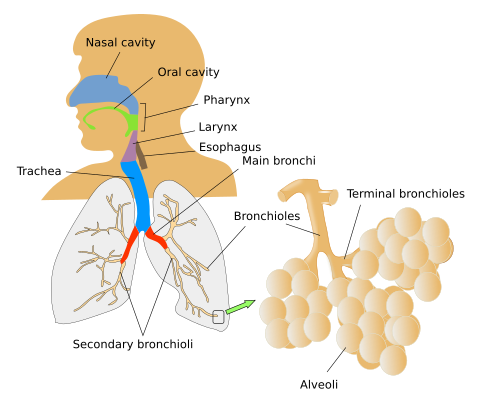The respiratory system is responsible for providing oxygen needed for cellular respiration and removing carbon dioxide generated during cellular metabolism. Both molecules are exchanged between the blood and the air. The respiratory system also performs other functions, such as providing air to produce sounds, renewing air over the olfactory epithelium of the nasal cavity to allow olfaction, and producing some hormones.
The respiratory system consists of a series of ducts through which the air is driven (Figure 1). It begins in the oral and nasal cavities, since both are airways through which air enters and exits. The nasal cavity contains the olfactory epithelium. Olfaction is closely related to breathing in pulmonary animals, and sometimes the rhythm of breathing is altered to increase the uptake and perception of odors.

The pharynx provides communication between the oral and nasal cavities and the larynx. It is a resonance zone during the emission of sounds. The larynx connects the pharynx and the trachea. Apart from being an air-conducting structure, the larynx is the phonation organ since it contains the vocal cords.
The trachea is a tubular structure that starts in the larynx and ends in the thoracic zone, where it branches out into two tubes that are called the main or primary bronchi. The trachea is lined with a mucosa composed of pseudostratified ciliated epithelium, containing some goblet cells (mucus-producing cells), and a lamina propria of connective tissue with many elastic fibers. More externally, there is a submucosa constituted by connective tissue that contains the secretory portions of some glands, mostly formed by mucous acini, even though some are mixed (serous and mucous). Underneath the submucosa, there are incomplete rings of hyaline cartilage, which in cross-sections (perpendicular to the major axis of the trachea) are C-shaped. These incomplete rings are distributed along the trachea. The muscle cells of the trachea connect the ends of the incomplete rings. The cartilage provides rigidity and elasticity to the trachea. The adventitia limits the external part of the cartilage.
The primary bronchi are the first two branches of the trachea. They, in turn, divide into the secondary bronchi and later into bronchopulmonary segments, according to the lobes of the lung. The bronchi have the same histological structure as the trachea, but when they enter the lungs, irregular cartilage plates replace the cartilage rings. While the diameter of the ducts is reduced, and after successive ramifications, the cartilage gets more scarce. At the same time, the smooth muscle layer increases. When the diameter of the respiratory duct is close to a millimeter, the cartilage is no longer observed, and then the ducts are called bronchioles.
Bronchioles give rise to terminal bronchioles, which in turn give rise respiratory brochioles, and then to pulmonary alveoli that are organized as alveolar ducts and sacs. In bronchioles, there is a transition from pseudostratified to simple epithelium, which changes from simple columnar to simple cuboidal, until reaching the alveoli, where it is simple and squamous. The goblet cells are scarce in the bronchioles and do not appear in the terminal bronchioles.
Alveoli are the terminal zones of the airways. The gas exchange takes place through their walls. Alveoli are formed of a simple, squamous epithelium surrounded by blood capillaries. The internal cavity of the alveoli communicates with the alveolar sacs or with the alveolar ducts. The walls of alveolar sacs and alveolar ducts are the alveoli themselves. Both structures communicate with the bronchioles.
Respiratory epithelium
T he respiratory epithelium lines the respiratory ducts. It changes from ciliated and pseudostratified in the trachea to columnar and cuboidal in the bronchi and bronchioles, and finally simple and squamous in the alveoli.
The respiratory epithelium protects against pathogens, pollutants, and allergenic substances. There are several protecting elements, such as a layer of mucus, the movement of cilia, the glycocalyx, and the cell-cell adhesion complexes of the epithelial cells. The asthmatic processes break the epithelial barrier and allow the invasion of pathogens and toxic substances that otherwise cannot cross the epithelium.
The mucus released onto the epithelial surface functions as a protective and defensive layer. This layer is moved toward the oral cavity by propelling forces generated by the movement of cilia. In this way, only the smaller molecules can cross the mucous layer, but not pathogens and potentially dangerous particles. The mucus is composed of water, salts, lipids, and proteins. It is viscous, adhesive, and shows some elasticity. These properties are provided by mucins, which are proteins released by goblet cells and mucous glands. Mucins get attached to the glycocalyx. There are about 21 different mucins.
The respiratory epithelium also releases lysozymes, transferrin, and antimicrobial peptides. Lysozymes are released by serous glands and attack bacteria. The transferrin removes the iron, which is necessary for bacterial proliferation. The respiratory epithelium is also capable of translocating IgM and IgA immunoglobulins, so they can cross from the blood to the surface of the respiratory ducts.
 Excretory
Excretory